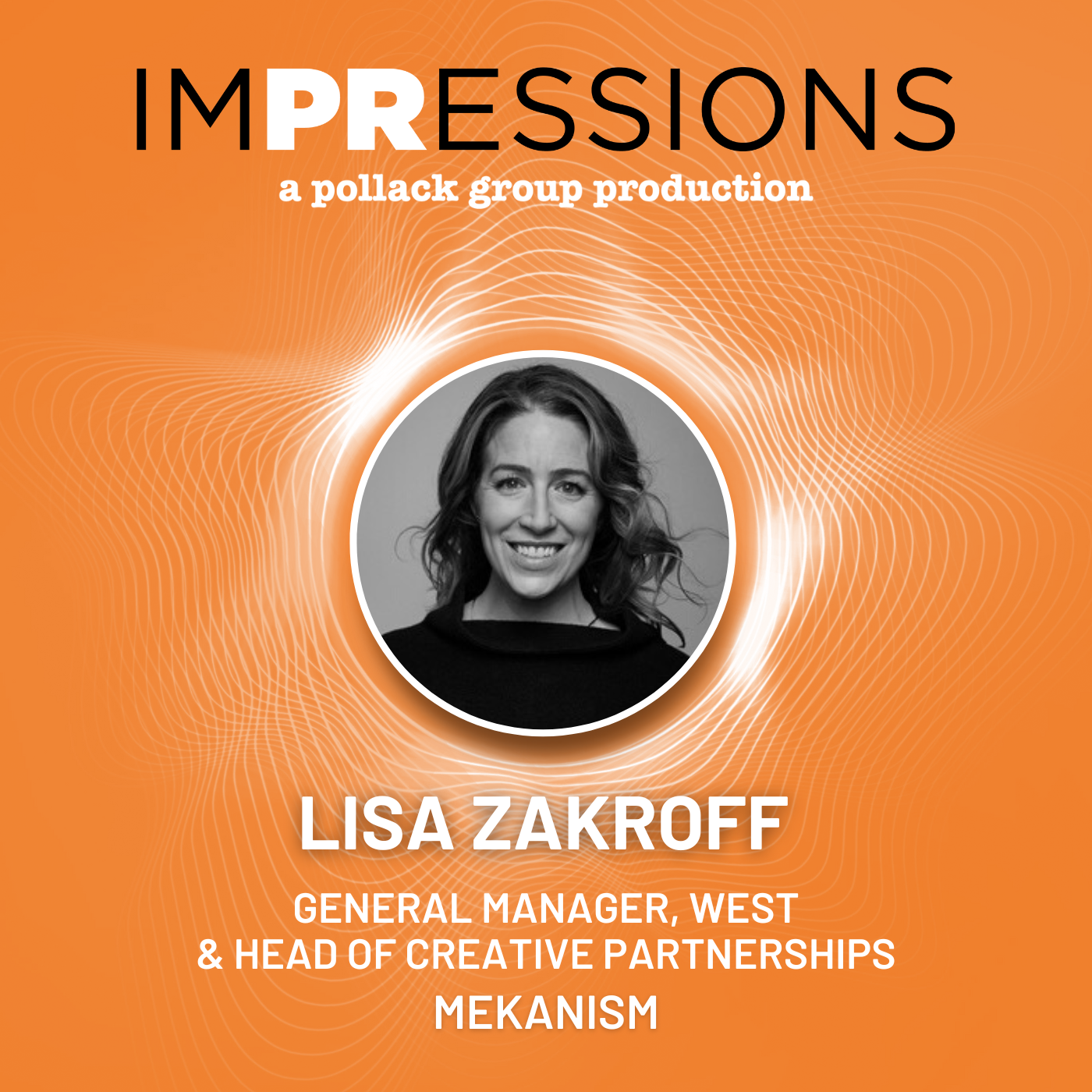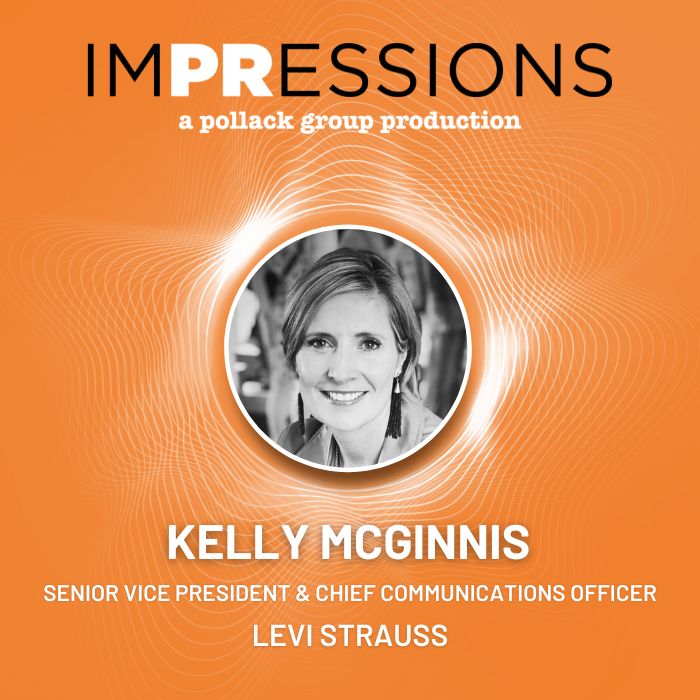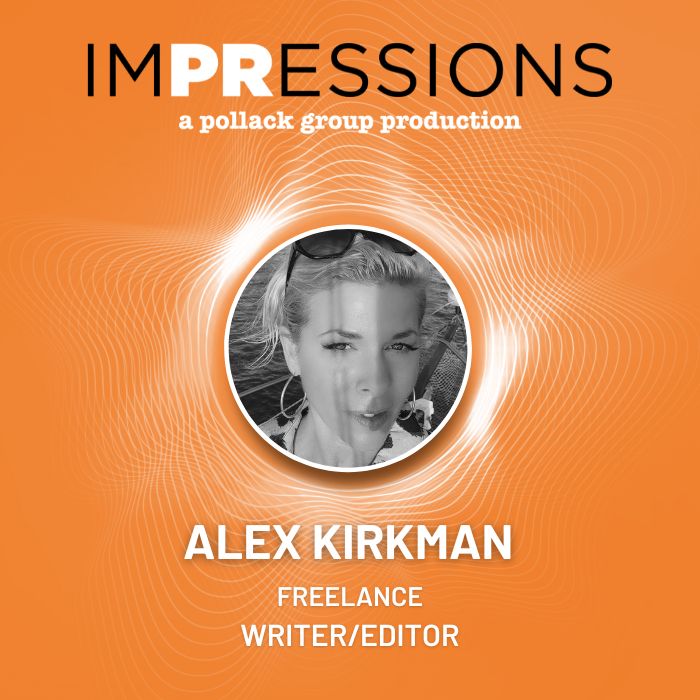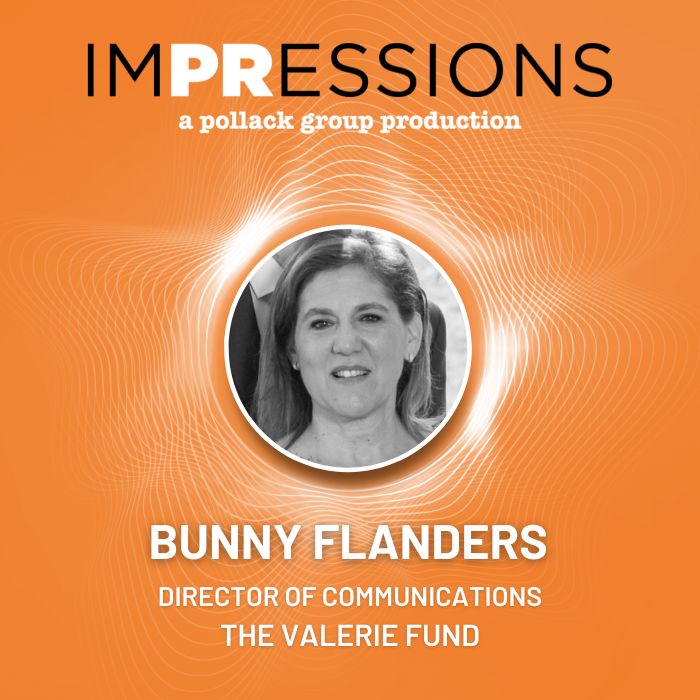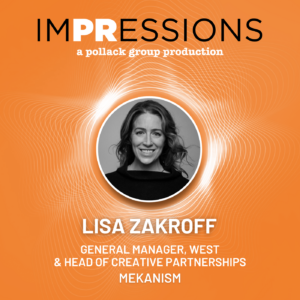
Between AI, the explosion of social media, and the continuous evolution of marketing, no other industry has transformed quite like advertising. From understanding a company’s core audience to strategically communicating brand products or services, advertising professionals must keep a keen eye on the market to ensure advertisements hit audiences at the exact perfect moment of impact. In episode 13 of imPRessions, Jenn and Kalli chat with Lisa Townsend Zakroff, General Manager at Mekanism and novel advertising expert who has developed campaigns for some of the biggest names in the world. Tune in for compelling insight into where the advertising industry is headed in the future!
Impressions Episode #13 Transcript
Kalli: According to the dictionary, advertising is the act of producing advertisements for commercial products or services. While it’s a centuries old practice, the strategies and tactics advertisers use today are anything but antiquated. In fact, it’s quite the opposite. Advertising professionals are tasked with not only knowing how to best communicate their products or services, but also with future casting as they are responsible for planning months in advance to ensure advertisements hit audiences at the exact perfect moment of impact. Our guest today, Lisa Zakroff General Manager at Mechanism, has led brand campaigns for heavy hitters such as Target, Burger King and Alaska Airlines, among many others, and continues to push the envelope and embrace the future of advertising. Lisa, thank you for coming on today.
Lisa: Happy to be here.
Jenn: Hi, Lisa. So I want to dive right in. You’ve had quite the impressive client roster under your belt. Can you tell us a little bit more about your career journey and what has led you to your success?
Lisa: Well, sure. I would say from a career standpoint, I’ve really worked at a diverse range of agencies. That’s maybe one thing that stands out, started in PR, went into traditional advertising, spent many years working on partnerships, and now I’m sort of back in a more what I guess I would call traditional advertising, although it really is non-traditional. I think the world is just moving into a non-traditional space as it is, but having kind of a well-rounded POV on marketing has for me been really helpful in kind of all the various challenges or roles that I’ve been in. I guess one other thing I would say is that from a personal level, I’ve really had a mentality of just taking ownership of what I’m working on, always wanting to drive things forward. I would say that I never want to be the reason that something’s dragging. If you take too long on anything, people maybe will lose interest, and it’ll sort of die on the vine, if you will. So keeping that momentum forward is a really big part of just how I try to approach each day and each project. And then sort of lastly, just having a background in PR has taught me to connect the dots on things. So always being able to relate what’s going on in the world to my clients and how can they become a part of something that’s in culture or trending and really sort of figuring out how even certain clients can be working together to help each other? So connecting the dots has been a big part of what I learned in PR that’s sort of carried me through my entire career.
Kalli: That’s really great. And, you know, now, you know, as a managing director, you know, how do you drive your team to be on top of and in even ahead of trends that the rest of the population hasn’t caught on to yet?
Lisa: So what I would say that’s great about an advertising agency sort of at its core is that it’s really set up to be thinking about what’s coming next. We have you know, we have specific kind of strategists and specialists on culture, on trends, on technology. And, you know, collectively we keep each other thinking about the future. So, for example, our planners are really tracking audience and evolutions and human insights so that whatever we’re bringing to the table is feeling really relevant to what people are experiencing in the moment. We also have a mechanism. We have a director of innovation who’s always on the cutting edge of AI, ChatGPT, whatever it may be in the moment. And you know, we’re having regular what we call medications for the whole agency. We’re even doing agency-wide competitions using some of these new platforms so that it’s really keeping us all in the know and understanding where the world is headed. And even with myself, you know, I have this background in partnerships. I’ve brought it to the agency, We’ve developed a creative partnerships practice, and as part of that, we’re meeting with really all of the companies and platforms who are shaping culture, whether it’s studios or streamers or toy companies, even to understand what’s coming and how can we be a part of it, whether it is, yeah, 12 months, 18 months out. But it helps us say for our on our client’s behalf, say, hey, you have a product that’s launching, and at the same time, this is what’s going to be happening. Let’s make sure that we’re a part of that conversation when this launches.
Jenn: So, you kind of have to be a little bit of a fortune teller, in a sense, to really be able to predict what the trends are going to be in the next 12, 18, 24 months
Lisa: To a certain degree. But I would say a fortune teller with connections because there are enough industries out there where they have to plan that far out. So, you know, if there’s a film being shot, it’s launching next year, but it’s being shot this year. So you know it’s coming, right? We know that Jurassic Park, you know, is going to launch in a certain month, in a certain year. So you kind of if you have the right access to the right information, then then you can be that fortune teller if you will.
Kalli: Yeah, that makes a lot of sense.
Jenn: Yeah, completely. I was just curious, though, like how do you advise your client who might be hesitant to jump into a campaign based on a future trend because they’re not fully convinced that even though that movie is coming out next year or, you know, the campaign is popular now, how do you convince them to just follow your lead and trust you?
Lisa: Sure. Yeah, that’s definitely one of the challenges at Mechanism. Our value proposition is all-around science. You know, we know the magic sort of happens somewhere in the middle of hard data and then the human insights and the gut instinct. So when we’re approaching any challenge, we sort of look at it from what is the data telling us? We have media tools. We have social listening tools. We have qualitative, quantitative research, sort of lay the groundwork from a data perspective, what we call the science. Then we have the strategists and the planners who are really tapping into the human insight around all of it and helping us kind of connect the dots between the two. And so when we do bring an idea to a client, they are kind of given we lay it all out for them. Here are the facts. Here is kind of the human insight and where culture is headed. And here’s why. This is something that we’re recommending and why we believe this is the right solution. So, you know, we’re never just sort of asking for a wish and a prayer where we are coming with all of the factual and data that we can. I do have one example. Maybe a good example of this would be we launched a film for our client, Alaska Airlines. It was kind of December of 2020.
Jenn: Oh my God, I love this video.
Kalli: I know. I’m so glad that this is your example.
Lisa: Oh, good, good, good. Well, you can imagine. So, this came out in. Yeah, December of 2020. It was a very kind of interesting time in the world. And, you know, we were working for Alaska Airlines who was saying, hey, we believe it’s safe to fly if you do it the right way. And meanwhile, the CDC was saying, hey, don’t fly. So, we were in this kind of interesting position. So we came to Alaska Airlines with a number of different options. And one of the options was this idea of the safety dance and having, you know, basically a whole corridor. To dance to the Men Without Hats, song, “Safety Dance”. And we had created all new lyrics for it around. You can fly if you want to. And it was featuring employees wearing masks, etcetera. This was a bit of a risk. I mean, people it felt like all of the advertising out in the world in this moment was very I mean, it was all the same. It was like a Covid soup of know we’re here when you’re ready and we’re thinking about you. And it was all very vanilla, is what I would say. But everyone was playing it safe. This one was we had to have the data to say, you know what? People might even trust the airplane itself and the filtration systems and everything we’ve been telling them, but they may not actually trust the people around them.
So how can we tell a message also in a fun way, in a fun and engaging way that’s respectful but also breaks marketing out of this Covid coma of marketing that we were in? So, it was a combination of both. And at the end of the day, we also kind of said to our to our clients, you know, people we actually believe people need this levity right now. This is we are a fun company. We have a fun brand. None of us have done anything fun in the last 9 to 10 months. What can we do to be a part of breaking people out of that? And so luckily, they agreed to it. We had a ton of fun making this thing, and then when it launched, we really didn’t know if it would be good, if people would love it or if people would revolt. And luckily it was wildly embraced. And even the surgeon general tweeted about it, and it was, you know, a lot of fun. But that did take trust from both a kind of the science perspective of here’s what we think will happen, but also just sort of the trust between a client and a and and an agency. We know what your brand needs to do in this moment. Let us try to do that for you.
Jenn: And love that you used real flight attendants and they were such good dancers. Like, if my boss tomorrow was like, We’re doing this dance, I would fail miserably. I’m a terrible dancer. And like, thought I was like, Oh, they hire professional dancers and actors. But these were authentically like actual airline employees, right?
Lisa: That is correct.
Jenn: That’s so cool.
Kalli: Yeah. I mean, I’m just going to say, Jenn, when I was younger, I actually my life goal was actually to be a Rockette. So, I’ll just dance in front of you. It was.
Jenn: Cool. Oh, my God. You’ll. You’ll have to dance in front of me. You’re a little shorter, but we’ll make it work.
Kalli: That’s exactly the exact reason why I am not a Rockette because I’m a lot shorter. But, like, I love this campaign because, like Jenn said, like you brought in real people. You brought a little bit of levity to, you know, what was a not only just vanilla but like a somber situation. And everyone was, you know, really looking forward to traveling again and visiting their family and friends and seeing new places or seeing places that they’ve seen before and, you know, being able to appreciate that. But you’re right 100% that even though that’s what everyone was thinking, that like, I can’t wait to get on a plane again, you do have to have that trust, especially, you know, in a situation like this. And you are being very creative and again, pushing the envelope. So, I think that trust is so, so important. And, you know, Lisa, we’ve talked a lot about getting, you know, both your team and your clients to hop on board to new and innovative ideas. But I want to take a step back and look at advertising as a whole. You know, how do you see the industry moving forward and, you know, kind of what does the next phase look like in your opinion?
Lisa: So as we look at marketing as a whole, it is becoming less and less segmented. You know, we used to be in a space where the ad agencies did the big TV campaign and then the PR agencies did the piece and you had the social agencies doing the social. It was very fragmented. And now we are looking at really when you are an agency and you’re responsible for a brand, you need to be able to come at it from a full funnel mentality. You need to be thinking about how are we going to have the upper funnel brand working in concert with the lower funnel conversion and consideration tactics. And no longer can we sort of just, you know, put up our blinders and focus on the thing that we’ve always done. And that is what we are seeing now more than ever before. And it’s partly because the media landscape is changing, but it’s also the way that we’re ingesting media and just sort of being able to be responsible for the entire funnel and follow the consumer journey from beginning to end is where I see marketing going and where really all agencies need to become proficient.
Jenn: Great. Absolutely. And you said something before about trust when you were talking about the Alaska Airlines campaign. And I think you and I can both agree that when it comes to advertising, public relations, and marketing, trust is obviously a crucial component. So how do you, as an advertiser, work to build consumer trust, especially as the world evolves digitally? Because there’s a lot of things happening right now that people just don’t trust social media, even some aspects of journalism. So, from an advertising perspective, how do you combat that?
Lisa: So, I would say this speaks a lot to what I was saying even earlier about full-funnel marketing because what brands need to do now is find the perfect balance between the brand and, ultimately, the conversion-driving work. You can’t just hit people with shop now Instagram posts and expect them to trust you enough to go and make that purchase. You have to build a relationship which really is going to start or, well, it’s very fluid, but you build this relationship and build a brand that they can connect with that they believe in. Maybe it even shares values with the consumer and where their mindset is at. And so I know a lot of there’s a lot of talk now with kind of CMOs needing to find the perfect balance of brand work versus mid-funnel versus lower funnel because there have been in some cases, clients have completely swung into the programmatic where you can get those immediate results. And while that feels good in the moment, you might actually be kind of losing the connection with the consumer at the brand level and therefore, it becomes more transactional and less of a relationship that’s going to be ongoing. So I would say that’s how you sort of help build consumer trust is showing up in all the different ways and having a value proposition that kind of speaks through in everything that you do. But certainly, to even to get there, I would say for agencies and for their partners, that client trust is also extremely important and at mechanism how we do that, because in order to pull off a lot of the things that you pull off, you have to have kind of implicit trust in each other. So we really believe in being close to our clients. We have offices in five cities close to where our clients are so we can have in-person meetings. We still very much believe in in-person meetings. We believe in being in the office two days a week and just trying to take the client-agency relationship beyond all of these Zoom meetings that we’ve all been sort of forced into, we think it’s really important to have that one-on-one connection.
Kalli: I love that you really do focus on building that relationship that trusts you, not just with the clients, but with the other people that you’re working with, because we all know that there are quite a few cooks in the kitchen when especially when working on big campaigns and and big projects. And, you know, you mentioned before that you started, you know, as a PR person. So, you know, we have to ask you as PR people ourselves, you know, how do you find that marketing agencies and PR agencies can best work together towards their common goals of, you know, getting their clients word out and and spreading the message and promoting what, you know, what the campaign is or the product is.
Lisa: Yes, these relationships are so important and they are some of the toughest thing they are. They can be very difficult to navigate. I think first and foremost, creating the relationship like personal level relationships as much as you can between and knowing that you’re really trying to collaborate. You’re not in competition. I think as much as the lines are blurring now, it feels like we’re in competition with each other and that is truly never the case, because if a campaign that we’re working on together is on the Today Show and, you know, massive success, like everybody wins. So just sort of having kind of those conversations and the upfront of what’s the goal? What are we trying to achieve together? And then having touchpoints along the way. So having a really good, you know, we call Iot process or cross-functional process. However, you talk about it, having internals before you even get to the brand. So having the PR agency, the marketing agency, the media agency, even working through some work together, concepting together, and then ultimately presenting together is the best way to do it because then everyone takes ownership. Everyone feels pride in the outcome, and hopefully, you know, it’s a swimming success.
Jenn: Yeah, I love that. It’s not a me versus you. It’s us together. Because if the campaign fails, then we all fail. So, sure, you know.
Kalli: One team, one dream.
Lisa: I mean, and listen, it can be hard. I will admit it can be really hard when the main idea is coming from one agency. So if, you know the ad agency sells through a big idea that then the clients come to the PR agency and say, Hey, this is what we’re doing, get on board. I do think that can be hard and certainly vice versa as well. So it is also there’s a lot on the brand to kind of make sure that all of the teams are on board and get on board because there’s nothing worse than launching a big moment and not having everyone working together because yeah, it’s you’re just then you’re launching with one arm behind your back.
Jenn: Absolutely. So as someone who’s been in the industry for, I guess, almost two decades now, and you’ve had a front-row seat to the evolution of advertising, so what advice would you give to someone maybe in college thinking about maybe joining the advertising industry or somebody very newly in their career? What would you say to those people looking to make their mark in the industry?
Lisa: So, I think folks coming into the industry now, especially post-COVID, is I sincerely feel for them. It has got to be it’s a whole new world to navigate. My recommendation would be to treat your new role as an apprenticeship because it is you know, this is a job that you learn on the job. There’s not a lot of college courses that really get into how to do this, right, whether it’s PR or advertising or media. So you need to learn from those who have the experience. It was a lot easier when we were all in the office five days a week to get that experience, to witness people in a meeting to see how they respond to different things. When we’re in more siloed environments. I do think it’s a challenge. So my recommendation would be treated as an apprenticeship. Find the people that you want that are your teachers essentially, and just soak it up. Like, really get the time with them. Go into the office. If you can nurture those business relationships as best you can, but really embrace the fact that you have a lot to learn and you need people to help you learn it. You’re not going to do it all on your own in a room.
Kalli: That’s so true, and definitely something that I did, you know, the beginning of my career. And I found a lot of I’ve learned a lot of things and I learned that I don’t know a lot of things.
Jenn: I still don’t know!
Kalli: Yeah. It’s really just really nice to be able to find those teachers like you said, and, and just to soak it all in and like, just always continue learning, you know, we. All are just continuing to learn and things are continuing to evolve, you know, and that’s one of the reasons we’re even having these conversations. It’s so that, you know, a learning experience for all of us, for us, for our listeners, you know, for our guests. And, you know, we really appreciate the time that you that you’re taking today to talk to us. And, you know, Lisa, thank you so much for sharing your insight on the future of the advertising industry. Hopefully, everyone will learn something new, and they soak up all the insight that you’ve shared today. You know, for those listening, as always, email us any time at impressions@pollackgroup.com and until you’re ready to soak up our next episode. Thanks again for listening.

